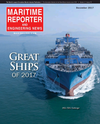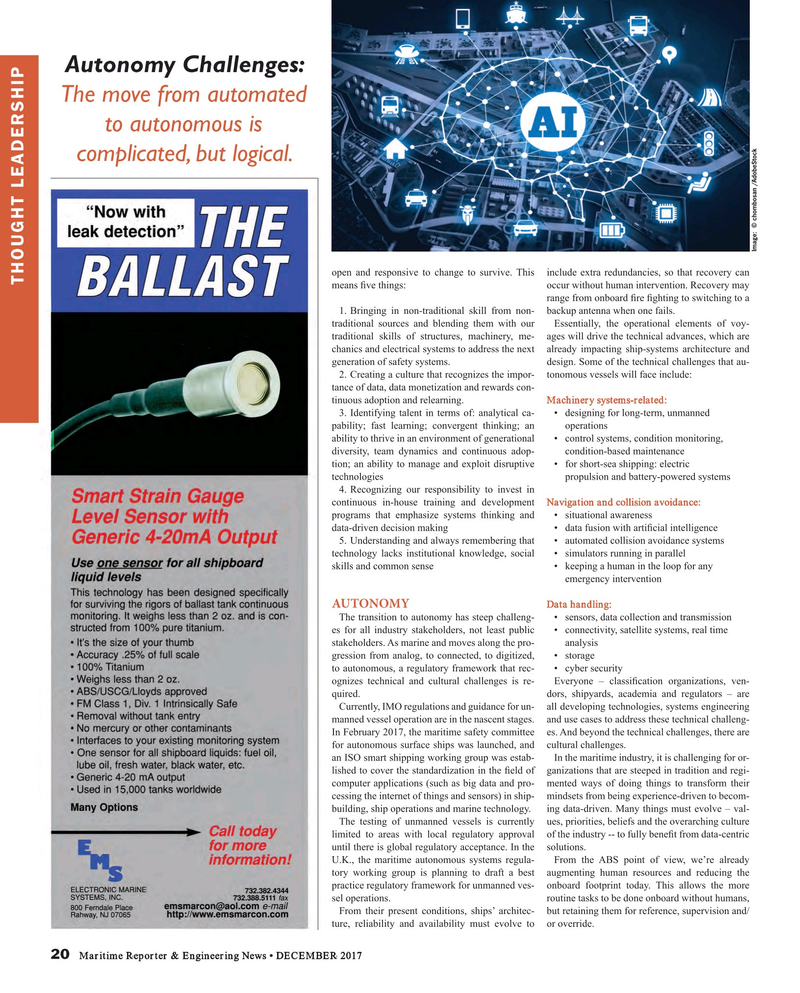
Page 20: of Maritime Reporter Magazine (December 2017)
U.S. Navy Quarterly
Read this page in Pdf, Flash or Html5 edition of December 2017 Maritime Reporter Magazine
Autonomy Challenges:
The move from automated to autonomous is complicated, but logical.
Image: © chombosan /AdobeStock open and responsive to change to survive. This include extra redundancies, so that recovery can
THOUGHT LEADERSHIP means ? ve things: occur without human intervention. Recovery may range from onboard ? re ? ghting to switching to a 1. Bringing in non-traditional skill from non- backup antenna when one fails.
traditional sources and blending them with our Essentially, the operational elements of voy- traditional skills of structures, machinery, me- ages will drive the technical advances, which are chanics and electrical systems to address the next already impacting ship-systems architecture and generation of safety systems. design. Some of the technical challenges that au- 2. Creating a culture that recognizes the impor- tonomous vessels will face include: tance of data, data monetization and rewards con- tinuous adoption and relearning. Machinery systems-related: 3. Identifying talent in terms of: analytical ca- • designing for long-term, unmanned pability; fast learning; convergent thinking; an operations ability to thrive in an environment of generational • control systems, condition monitoring, diversity, team dynamics and continuous adop- condition-based maintenance tion; an ability to manage and exploit disruptive • for short-sea shipping: electric technologies propulsion and battery-powered systems 4. Recognizing our responsibility to invest in continuous in-house training and development Navigation and collision avoidance: programs that emphasize systems thinking and • situational awareness data-driven decision making • data fusion with arti? cial intelligence 5. Understanding and always remembering that • automated collision avoidance systems technology lacks institutional knowledge, social • simulators running in parallel skills and common sense • keeping a human in the loop for any emergency intervention
AUTONOMY
Data handling:
The transition to autonomy has steep challeng- • sensors, data collection and transmission es for all industry stakeholders, not least public • connectivity, satellite systems, real time stakeholders. As marine and moves along the pro- analysis gression from analog, to connected, to digitized, • storage to autonomous, a regulatory framework that rec- • cyber security ognizes technical and cultural challenges is re- Everyone – classi? cation organizations, ven- quired. dors, shipyards, academia and regulators – are
Currently, IMO regulations and guidance for un- all developing technologies, systems engineering manned vessel operation are in the nascent stages. and use cases to address these technical challeng-
In February 2017, the maritime safety committee es. And beyond the technical challenges, there are for autonomous surface ships was launched, and cultural challenges. an ISO smart shipping working group was estab- In the maritime industry, it is challenging for or- lished to cover the standardization in the ? eld of ganizations that are steeped in tradition and regi- computer applications (such as big data and pro- mented ways of doing things to transform their cessing the internet of things and sensors) in ship- mindsets from being experience-driven to becom- building, ship operations and marine technology. ing data-driven. Many things must evolve – val-
The testing of unmanned vessels is currently ues, priorities, beliefs and the overarching culture limited to areas with local regulatory approval of the industry -- to fully bene? t from data-centric until there is global regulatory acceptance. In the solutions.
U.K., the maritime autonomous systems regula- From the ABS point of view, we’re already tory working group is planning to draft a best augmenting human resources and reducing the practice regulatory framework for unmanned ves- onboard footprint today. This allows the more sel operations. routine tasks to be done onboard without humans,
From their present conditions, ships’ architec- but retaining them for reference, supervision and/ ture, reliability and availability must evolve to or override.
20 Maritime Reporter & Engineering News • DECEMBER 2017
MR #12 (18-25).indd 20 MR #12 (18-25).indd 20 12/6/2017 1:36:08 PM12/6/2017 1:36:08 PM

 19
19

 21
21
